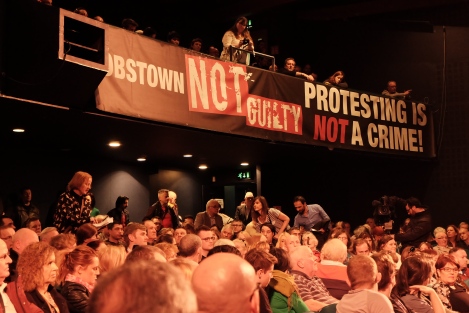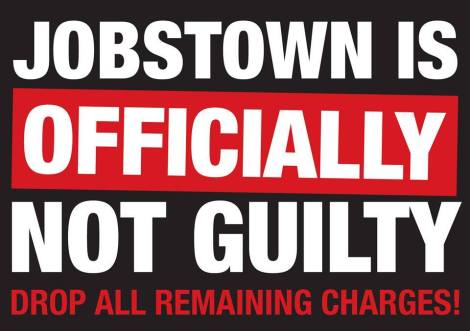Earlier this summer, the return of a Not Guilty verdict left Ireland’s political and media establishment in shock. Sami El-Sayed talks to TLR about the social media campaign which fought the establishment narrative regarding the trial.
On 29th June, the first round of Jobstown defendants were declared not guilty with a unanimous verdict. The media’s reaction was puzzling and bizarre – the response from The Irish Times, a “paper of record”, was damning; “Jobstown trial struck a modern, and very disturbing, tone”, the editorial described defendant Paul Murphy’s conduct in response to being found not guilty as “politicking at its most crude”, opposing Murphy’s call for a Public Inquiry into the case. An Taoiseach Leo Varadkar described the protest as like “a scene from Lord of the Flies” – after the not guilty verdict.

In the course of the two and a half years running up to the trial, the protesters were called “INLA gun thugs”, “fascists”, and were slandered in a variety of different ways by every single mainstream news outlet in the country, as well as by representatives of the parties of the establishment. Fine Gael TD, Noel Coonan, said that the activity of “the Murph” and others had to be “nipped in the bud” or else Ireland would “be facing an ISIS situation”. RTÉ’s Claire Byrne said to Paul Murphy that “[he] falsely imprisoned the Tánaiste”.
The establishment made liberal use of identity politics by selectively charging men almost exclusively, and then proceeding to smear the defendants as misogynistic and sexist, despite the huge numbers of women who protested that day.
From the first days after the protest, the media gave air to views which described the protest as a riot, as a kidnapping, as violent, and even as terroristic. Going exclusively by the coverage of The Irish Times during the trial itself, the case was a very clear cut guilty verdict with the vast majority of the coverage being given to the limited prosecution case and little given to the cross examination which debunked it.
The most dangerous man in Ireland
Enter the hashtag. ‘#JobstownNotGuilty’ saw its first use in mid September of 2015, after dawn raids saw dozens of people arrested. At the same time, the Jobstown Not Guilty Facebook page was established. With these two tools, a handful of activists would completely out-do the media narrative.
The real shift began around March of 2017 when the Jobstown Not Guilty social media campaign began in earnest, alongside Solidarity – The Left Alternative’s own social media campaign – of whom four members(three of which were elected representatives) were on trial. There was a clear two-pronged approach; On the one hand, the Jobstown Not Guilty campaign would use its platform to highlight the facts of the case and point out the false statements made by the prosecution and its witnesses, whereas Solidarity would bring sharper analysis with commentary and interviews.
While there was a team of people working behind the scenes with Solidarity’s social media, the face of its activities was undoubtedly the “Solidarity Reporter”, Dave Murphy. The immensely high profile that he developed for his consistent commentary on the case resulted in several articles being published on him after the verdict, with The Phoenix labelling Dave Murphy as “the most dangerous man in Ireland”, as well as other outlets labelling him as “Murphy the Lesser” or “the twerp”. Solidarity’s videos would consistently hit thousands of viewers, and would often out strip the articles produced in the major media outlets on the case in terms of circulation.
Hand in hand with that effort, the Jobstown Not Guilty page produced several short and pointed videos about key points around facts on the trial. One video showing helicopter footage of the protest netted 865,000 views. Another showing Paul Murphy’s interactions with the Gardaí 420,000 views. Another, showing video from Joan Burton’s phone submitted as evidence to the courts, got 400,000 views. A 23-minute documentary that was independently produced got 110,000 views.
My own experience on the streets as a part of the campaign told me that these videos had a decisive impact on informing people, with many conversations involving people commenting on this or that video that they saw which completely convinced them of how absurd the whole trial was. On the March for Justice which happened in May 2017, I spoke with a man who told me he wasn’t going to come on the protest until he saw the aforementioned helicopter footage. There have even been amusing anecdotes of Dave Murphy being recognised on the streets, as opposed to Solidarity’s own elected TDs.

Media mistrust
Of course, it’s a mistake to think that the activists running the social media apparatus of the campaign orchestrated this huge enthusiasm and interest artificially. Generally speaking, the videos produced by the campaign were not particularly ground breaking nor were they unique. Rather, the huge circulation of social media in support of the defendants was a product of the campaign’s perspective and analysis. It was understood that working class people would tune into the trial as things developed – and that the first port of call for most people would be the establishment’s media.
Naturally, there is an instinctive and significant mistrust for the media’s narrative on the part of working class people. The follow up once the trial was brought into an individual’s consciousness, then, would generally be to look for alternative sources of information. It was with this in mind that the Solidarity/Jobstown Not Guilty campaign intervened into social media. Rather than creating the buzz itself, the campaign prepared for a sentiment that was likely to develop and then reaped the rewards once it did. It’s because of this awareness that one of the very first videos produced by Solidarity was an interview with former-TD and political giant of the left, Joe Higgins, in which he analysed the coverage that the papers gave to the trial. If people were going to look for alternative sources of information, they had best know that the information they got initially was skewed beyond belief. The numbers speak for themselves as for the effectiveness of that approach.
Despite the earlier Not Guilty verdict, the trials of the remaining Jobstown Defendants are ongoing. You can see how you can help their cause by clicking here.
Celebrity endorsements
Another aspect of the social media campaign around the trial that cannot be overlooked is the effort by activists to reach out to “big names” in search of support. Huge figures in international academia such as Noam Chomsky threw their support behind the campaign, as well as major political figures such as French Presidential candidate Jean-Luc Mélenchon.
Using the international links of various activists in the campaign, dozens of MEPs and other elected representatives from all around the world – including as far as Hong Kong – as well as major trade union figures(Such as UNITE the Union’s Len McCluskey representing millions of workers) all gave their support to the campaign. It was especially striking to people for them to see the (actually)falsely imprisoned Paddy Hill of the Birmingham Six get actively involved in the campaign. Jacobin, an American magazine with hundreds of thousands of followers, wrote in support of the campaign.
The result was a significant social and political legitimisation of the campaign in the first place, which translated into a deepening of support. The key point here is that the media in Ireland did not cover this – or rather, it covered it as little as it could get away with. While it was happy to give a platform to people to smear the defendants in the public arena, shaping people’s views on the protest in the years preceeding the trial. The media refused to show the broad level of international support for the campaign for fear of “prejudicing” the trial – that is, for fear it might impact people’s views on the protest, and more specifically might counteract the smearing of protesters that the same media had previously carried out.
The end result meant that social media had to do the legwork. At a point in the campaign, the Jobstown Not Guilty page was an endless stream of picture, video and text endorsements from various international figures, worker meetings, conferences and so on. Not many of these got wide recognition, but to this day I still see people with Noam Chomsky’s statement in support of the campaign as their profile pictures on social media.
Repeating the campaign
While it is right that we celebrate the clear and demonstrable success of the campaign, there needs to be a perspective kept. It’s clear that without social media and the huge hours put into building a social media campaign, that the public perception of the trial would have been different, and stacked much more against the defendants. While that perception (in theory) does not effect the legal outcome of not guilty, it does effect the political outcome. As a Socialist, I am fearless about politicising this trial, and as a result we need to be thinking about the lessons of the campaign and how to apply them in the future for political work.
Can the methods of Jobstown Not Guilty and Solidarity’s reports be applied to working class struggles? Can we use them to put pressure on the establishment parties and to vie in a serious way for narrative hegemony? I think the answer is a resounding “Yes”. The question then is a matter of organisation and building independent media which has a clear political line and a combative approach. With proper resources, human and otherwise, there is no doubt that the success of the campaign can be duplicated across various issues, and that these successes can be used to build media organs of the working class which can dominate the narrative. In the past, working class parties had papers with a circulation and readership that eclipsed pro-capitalist media. That time can come again, and is coming again.
